 I’ve done some work with the big magnums sold by CZ-USA. They are… enjoyable. They are traditional heavy weights; special application rifles that combine traditional styling and design with just a little bit of fancy and with some of the most powerful cartridges available today. This will be a two or three part project, this first part is overview and familiarization.
I’ve done some work with the big magnums sold by CZ-USA. They are… enjoyable. They are traditional heavy weights; special application rifles that combine traditional styling and design with just a little bit of fancy and with some of the most powerful cartridges available today. This will be a two or three part project, this first part is overview and familiarization.
|
CZ Safari Classic Magnum Express |
|
| Manufacturer | Česká zbrojovka |
| Model | Magnum Express Rifle |
| Type | Bolt Action Square Bridge Mauser |
| Caliber | 450 Rigby |
| Magazine Capacity | 3 |
| Barrel Length | 24″ |
| Rifling | 1:10″ (Yes, Really) |
| Weight | *10 lbs 4 oz. |
| Overall Length | 38.5“ |
| Stock | #1 Fancy Grade American Walnut |
| Hardware | Matte Carbon Steel |
| Length of Pull | *13.7″ |
| Drop at comb | *0.5″ |
| Drop at heel | *0.8″ |
| Sights | Interchangeable Front, Folding Express Rear |
| Scope | 19mm Integral |
| Trigger | Adjustable – Single Set |
| Safety | 2 Position |
| MSRP | $3013 |
|
* Actual weights and measures |
|
Notable – The tight twist rate; spec checked and verified, then checked again with Triple River Gunsmithing in Warsaw, MO, the folks who build the CZ-USA Safari Classic Rifles for CZ. This rate is 4″ tighter than most guns manufactured for this bore and cartridge type. Triple River says the guns are very accurate, so we’ll take a look. My guess is that my initial view will quickly become semi-interesting conjecture, as these folks build serious rifles that have proven themselves in dire circumstances.
A 0.458″ bullet from a big and dangerous game cartridge does not require much of a twist rate to stabilize; 14″ is common, 12″ is some cases. The only reason not to twist too tightly is that higher rotational speeds tend to emphasis the effects of a bullet’s material or aerodynamic imperfections. A 14″ twist would turn a 2,400 fps 0.458″ bullet at 123,000 RPM. The 10″ twist would elevate this to 172,000. Small diameter bullets turn faster as a routine, but they have much less mass and a slower surface speed generating forces.
Overall appearance… This is a guy’s gun. It’s beefy in a way that is beneficial; good magazine capacity, good recoil dampening heft. The stock is… pretty, dense and highly figured American black walnut, but not Swiss lace fancy. Good finish… nice oil rubbed look, clear through to the grain. Matte hardware is a great finish. I never understood the appeal of bright metal on a hunting rifle except for a person who is a member of PETA and conflicted over what constitutes fair chase.
The express sights are appropriate. They can be regulated to specific ammo and the front sight post is interchangeable with the press of a button. I like the brake, and so does anyone who has to shoot these things through a good number of rounds. At this point in the project, I do not know how effective it is, but we’ll soon find out. The thread cap leaves a finished look when the brake is not in place. The 24″ barrel is sufficient… more than sufficient, so I am not sure why I would like a 26″ barrel, other than that I prize velocity over all else.
The bolt stroke is long, but then so is the cartridge. It is Mauser like in operation, which isn’t a bag of ball bearings, but it is very smooth. The magazine release opens and closes cleanly, so no cycling to empty the gun. I like the keyed integral ring bases. They work well in holding a scope in place even when recoil may turn the shooter into a dashboard bobble head.
A virtual cornucopia of… accoutrements
The express sights are not vestigial artifacts… I like to use words in new, creative and inappropriate ways. The point is, this is a gun typically used close in on big and dangerous game… scratch that… Really big and dangerous game where shooting distances in brush may be very short, animals very large and those two factors combine to make a scope the wrong choice. I believe in the 100 meter leaf, I suppose I could stretch to the 200 meter leaf. The 300 meter leaf I will reserve for all of the Internet guys who routinely shoot one eighth MOA 500 yard groups with penny a round ammo. The sight base is integral to the barrel, the leaves and pins are thick and secure so that they won’t recoil off. The front sight hood will go nowhere under recoil. The little light window is a nice touch that really lights up the front bead. The post is secured with a push button release.
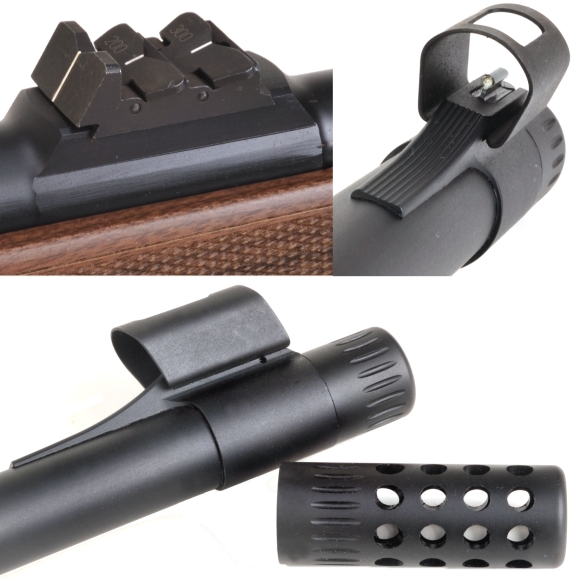
Haven’t tried the brake yet. The passage length and count seems right to be effective in cutting recoil and they are at right angles to the bore, so it shouldn’t slick my hair down on discharge or blow out my ear drums. The thread protector cap is a nice touch and the hole is big enough to hang one or the other on a key chain. On a more serious note, brakes are essential on a gun of this type. Perhaps not in the field where adrenaline or being chased by a lion would lesson the effects of recoil, but certainly at the range when developing shooting skills with a gun that will be used under stressful and dangerous situations.
Recoil management
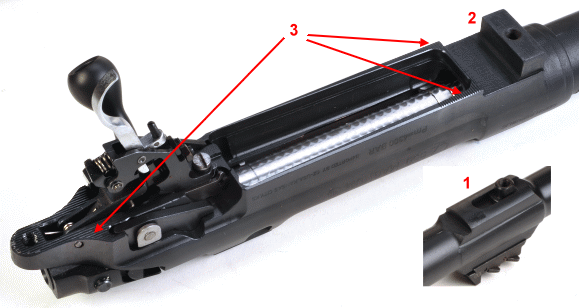
The heavy caliber CZ 550 based firearms have a lot of recoil management incorporated into the design. The barrel under lug is integral to the heavy barrel (1). It abuts a large metal finger locked stay in the gun’s forearm, a large integral recoil lug (2) locates the front of the action and serrated contact points grip (3) and hold the action to the stock. This multi faceted approach spreads the load over the surface of both hardware and stock so no one point, like the wrist of the stock, takes the total hit. A little better picture as a mechanical assembly –
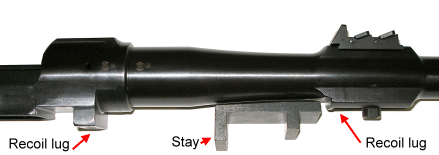
The stock systems compliment the hardware systems. Three large fasteners locate the barrel and action, two cross bolts lend indirect support. Lots of surface area spreads the substantial recoil to prevent stock or hardware stress failures.
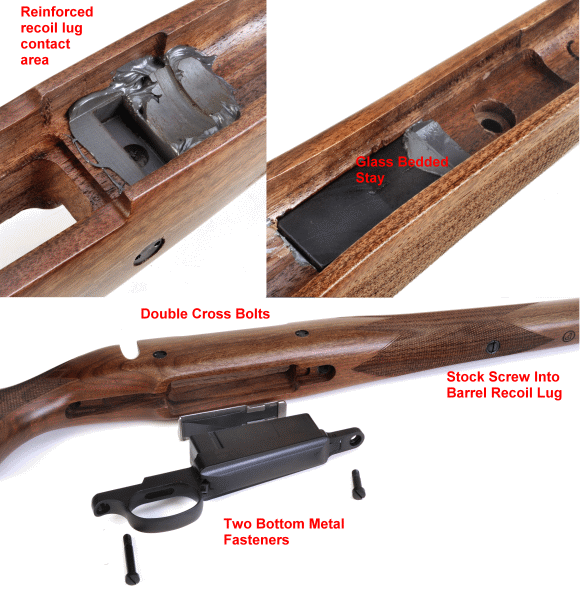
Trigger, without Roy Rogers… Ask someone who is older.
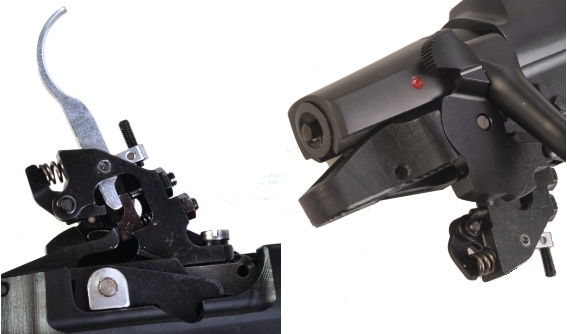
Sometimes I think a CZ is worth the purchase price just for the function and value of the trigger. It is slick, infinitely adjustable and it is a push forward to set trigger. Unset, pull is measured in pounds. Set, pull is measured in small quantities of ounces. Above, right, a close up of the easy to reach and actuate safety lever and the cocked indicator at the rear of the bolt shroud.
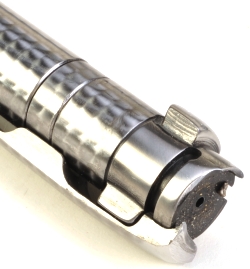
The Safari Class Magnum Express Rifle is a controlled round feed firearm, as are all CZ Mauser actions. In this case, the bolt and extractor, pick up a round from the magazine and hold it against the bolt face as it is driven to the chamber. The bolt and extractor on this gun feature optional jeweled finish.
I have used numerous guns of the controlled round and push feed persuasion and I can say, beyond a shadow of a doubt, the use of either is irrelevant to me, both feed reliably and smoothly in quality guns. The benefit to this type of set up is the large contact area and subsequent gripping force it can apply to an extracting cartridge.
The other nice aspect of this gun’s action is the ability to comfortably handle an 0.590″ cartridge rim.
Then and now…
My last work up was with a CZ Safari Classic 500 Jeffery ended up eclipsing 8,000 ft/lbs of energy, produced with bullet weights from 535 to 600 grains. The gun was beautiful, the workmanship top notch, ballistics impressive when hot-rodded (I don’t know what I was thinking), but the recoil was brutal even with mercury tubes, a Decelerator recoil pad and an eleven pound rifle. A morning spent shooting from the bench left me with a concussion headache, strained eyes, deep rotator cuff bruises from hyper extension, and no continuing interest in shooting jumbo magnums for awhile. Additionally, 500 Jeffery material was very expensive in every respect; firearms, reloading equipment and tools and cartridge components. After a long, hard look at firearms, ballistics, ammunition and associated cost, the 450 Rigby was chosen to revive my interest in big guns.
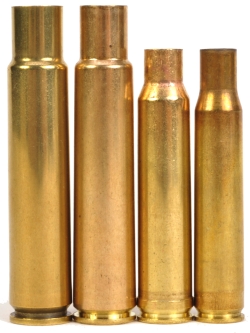 While the 450 Rigby is near in physical form to the 460 Weatherby, the 450 Rigby’s published performance specifications suggest it lags. On closer examination, where the Rigby’s 133 grains it is only 8 grains less than the 460 Weatherby, the Weatherby published data is based on a 26″ barrel length, two inches longer than the Rigby, and the Rigby’s maximum pressure is listed as 58,000 PSI compared to the Weatherby’s 63,800 PSI limit. Put both cartridges on equal pressure and barrel length footing and there isn’t a sneeze of a difference between the two. With still a lot more test and assessment work ahead , I believe the 450 Rigby can comfortably push a 500 grain bullet to 2,450 fps from a 24″ barrel and generate just about 6,600 ft/lbs of kinetic energy – our project objectives.
While the 450 Rigby is near in physical form to the 460 Weatherby, the 450 Rigby’s published performance specifications suggest it lags. On closer examination, where the Rigby’s 133 grains it is only 8 grains less than the 460 Weatherby, the Weatherby published data is based on a 26″ barrel length, two inches longer than the Rigby, and the Rigby’s maximum pressure is listed as 58,000 PSI compared to the Weatherby’s 63,800 PSI limit. Put both cartridges on equal pressure and barrel length footing and there isn’t a sneeze of a difference between the two. With still a lot more test and assessment work ahead , I believe the 450 Rigby can comfortably push a 500 grain bullet to 2,450 fps from a 24″ barrel and generate just about 6,600 ft/lbs of kinetic energy – our project objectives.
Pictured right, left to right, 450 Rigby, 416 Rigby, 338 Winchester Magnum, 30-06 Springfield. The 416 Rigby is the parent cartridge of Rigby’s 1995 introduction of the 450 Rigby. The 416 Rigby, a very modern looking cartridge, was introduced in 1911*. In peer and sort of peer context, the 450 Rigby looks a bit like this –
| Cartridge | COL” | Case Length” |
Major Shoulder ø “ |
Case Head ø “ |
Case Capacity Grains |
Maximum PSI |
500 Grain Bullet** FPS |
| 460 Weatherby | 3.750 | 2.913 | 0.561 | 0.582/0.604* | 141 | 63,817 | 2600 |
| 450 Rigby | 3.750 | 2.894 | 0.571 | 0.589 | 133 | 58,015 | 2100 |
| 458 Lott | 3.600 | 2.800 | 0.481 | 0.513/0.532 | 110 | 62,366 | 2300 |
| 458 Winchester | 3.340 | 2.500 | 0.481 | 0.513/0.532 | 95 | 62,366 | 2116 |
|
* Belt Dimension – **550 Grain Rigby Bullet |
|||||||
My assessment is that the 450 Rigby, like the 416 Rigby parent, is very conservatively loaded, particularly in regard to the Norma factory ammunition that serves as the basis for the indicated velocity. Gees, never were so many words use to express so little. I are a writer.
Status and considerations…
Dies for the 450 Rigby aren’t that bad in price, about $115 for a set of full length sizer and seater Safari dies at one of the online discount suppliers. I already had a #37 shell holder on hand, however, I had no bullets on hand. Lots of 0.458″ bullet but none specifically designed for a high flying big bore and none of the eight tons of .45-70 Gov’t bullets on the bench were really appropriate. Bullets are on the way, with an emphasis on heavier weights, solids and expanding.
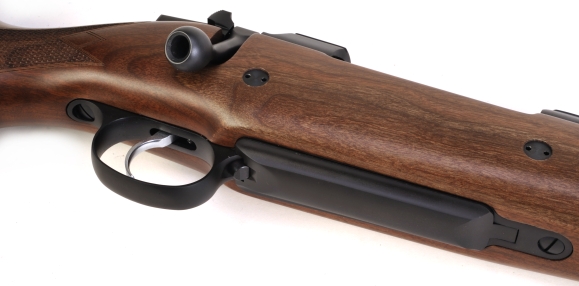
Brass availability, not so much. I had fifty Jamison casings on hand and they proved to be… terrible. Way too soft, some shoulders were malformed and they were not inexpensive. Norma brass is on the way which, I am sure, will be of good quality. Lots of other projects in process, so I suspect it will be 30 – 60 days before I get back with a Part II but, unlike Arnold, I will be back.
CZ’s Safari Classic Magnum Express Part I
CZ’s Safari Classic Magnum Express Part II

Email Notification